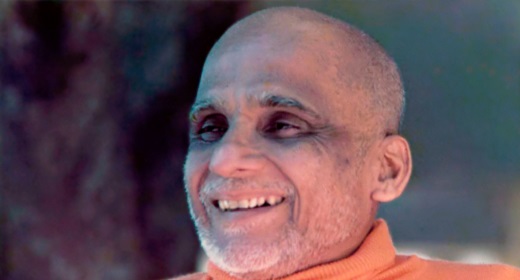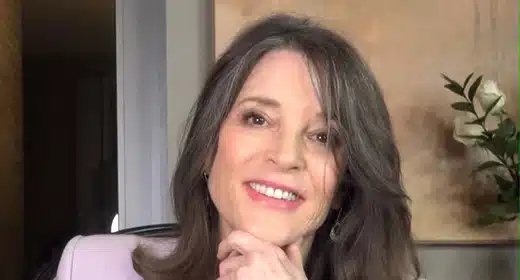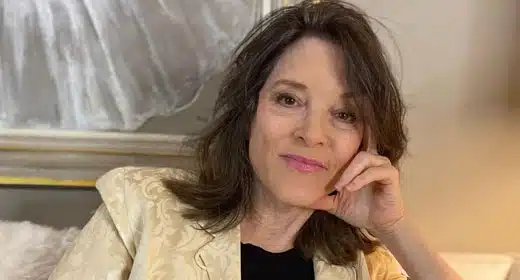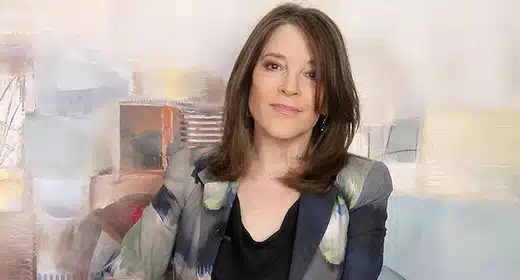Approached as a spiritual practice, a committed relationship can be a path not only to enduring love and deep harmony but also to liberation.
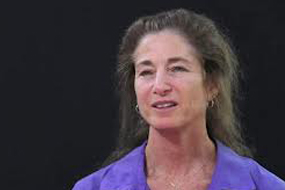 by Tara Brach: When Molly and Dave arrived at my office for their first therapy appointment, they were quiet and grim. Molly headed for a seat in the center of the small sofa, and Dave squeezed in next to her. As he stretched his arm out along the back of the couch, Molly immediately moved to the far end, folded her arms, and crossed her legs. Throughout the session, they both addressed me, rarely even glancing at each other.
by Tara Brach: When Molly and Dave arrived at my office for their first therapy appointment, they were quiet and grim. Molly headed for a seat in the center of the small sofa, and Dave squeezed in next to her. As he stretched his arm out along the back of the couch, Molly immediately moved to the far end, folded her arms, and crossed her legs. Throughout the session, they both addressed me, rarely even glancing at each other.
The story they told was not unusual. A little over a year ago, they had fallen deeply in love, and for months, making love had been a passionate and intimate experience they both relished. Hardly a day passed without them finding some time to express their passion. But over the past couple of months, Molly had been cooling to sexual intimacy, leaving both of them confused about how to continue with each other. Even though they had agreed that it was OK if their sexual interest followed different rhythms, Dave continued to approach Molly amorously every day. By the time they came to see me, she was regularly rebuffing his approaches with anger. “It’s like he’s been imposing himself, totally disregarding who I am, what I want,” she said. “He’s not giving me a choice.” But she also felt guilty when she saw the hurt in his eyes. “I just can’t believe I get so mean, so hard-hearted,” she added. “But this is just how I feel…I can’t stand being treated like an object!”
Dave protested that to him, Molly was “the furthest thing from an object.” Eagerly and sincerely, he declared, “She’s a goddess to me…really! She’s so good, so beautiful. I just want to express my love, to surrender into her.” He talked about how pained and frustrated he felt every time she rejected him. Looking at her pleadingly, he said, “Molly, you mean so much to me…How could you not see that?”
For the past three decades, I have been working with psychotherapy clients and meditation students who are grappling with their fears about and longings for intimacy. For many, the dance of intimate relationship is what feels most meaningful in life. Yet besides the joy and communion they may have found, they inevitably suffer the anguish of conflict and hurt. In my work (as well as in my own marriage, divorce, and subsequent partnership), I’ve seen how readily we can fall into reactivity, how easily we can get locked into the role of victim or “bad guy.” During these times, all the potential and promise of love get bound up in blame and defensiveness.
John Schumacher, an internationally known teacher of Iyengar Yoga, points out that “any deep connection with another naturally pushes us up against our edges.” Speaking of his own marriage as a fertile source of insight and inspiration, he says, “Like a spiritual teacher, our partner knows us—knows when we’re selfish, stuck, caught in feeling separate.” Schumacher notes that relationships, like asanas, require the willingness to remain present for the difficulties and challenges that inevitably arise. “Discomfort and imbalance are flags that adjustment is needed.”
Just as being present with pain or discomfort in a yoga asana can release blockages and bring the body and mind into harmony, being fully present with uncomfortable conflicts that arise in a relationship can bring us back into harmony and communion with ourselves and our partner. Through what we might call the yoga of relationship, we discover our connectedness and realize the loving awareness that is our deepest nature.
When we enter into an intimate relationship, few of us escape visitations of insecurity and shame, of aversion and jealousy. Learning to bring an openhearted presence to these kinds of feelings, rather than reacting out of fear or hurt, is not easy. But when we are willing to stay put and pay attention at precisely the moments when we most want to lash out, cling tightly, or pull away, our relationship becomes a path of deep personal healing and spiritual transformation. As with any type of yoga, one of the blessings of the yoga of relationship is the profound inner freedom that comes from realizing the goodness and beauty of our essential Being.
Cultivating Compassion
When they arrived for their next session, Molly and Dave (not their real names) immediately launched into their own versions of how the other was causing hurt and confusion. I suggested to them that instead of focusing on each other, they both begin to investigate their own feelings more closely. They were puzzled but curious and willing. “When intense feelings of desire or aversion arise during the week, consider these as signs to stop and pay attention,” I told them. “It might be hard to remember at first, but if you clearly commit to pausing in this way, I can guarantee you it will make a difference.” They glanced at each other for a moment and then nodded in agreement.
Learning to pause is the first step toward transformation and healing. We pause by stopping what we’re doing—we stop blaming, withdrawing, obsessing, distracting ourselves. In the space a pause creates, our natural awareness arises, allowing us to be mindful—to recognize what is happening inside us without judgment. By pausing, we begin to dismantle lifelong patterns of avoiding or distancing.
I suggested to Molly and Dave that after pausing and becoming still, they would be able to gain insight into their reactivity rather than being carried away with the momentum of blame or shame. The next step would be to ask themselves, “What is happening inside me right now?” and then bring wholehearted attention to whatever was taking place in their bodies and minds—the squeeze of anxiety, the heat of anger, the stories of who did what. They might even name the thoughts, feelings, and sensations, if doing so would help them stay focused and investigate what they were actually experiencing.
Then I introduced what is perhaps the heart of the practice. While continuing to notice whatever was most predominant or difficult, Molly and Dave were to ask themselves, “Can I accept this experience, just as it is?” Whether we’re fuming with anger, dissolving in sorrow, or gripped by fear, our most powerful and healing response is an allowing presence—not indulging or wallowing in our feelings but simply acknowledging and experiencing what is happening in the present moment. By accepting what is, we let go of the story of blame that either pushes away our partner or condemns our own feelings as bad or wrong.
I call this courageous kind of attention radical acceptance. It is a way of regarding whatever is happening within us with the two wings of awareness: mindfulness and compassion. With mindfulness, we see clearly what is going on inside us, and with compassion, we hold whatever we see with care. By bringing radical acceptance to our inner experience, we recognize and transform our own limiting stories and emotional reactions. We are freed to respond to our partner with creativity, wisdom, and kindness; we can choose love over being right or in control. Even if only one partner meets conflict with less defensiveness and a more accepting presence, the relational dance begins to change. In place of the familiar chain of reactivity, each person’s vulnerability and goodness shine through.
The Doorway to Connection
At our session the following week, Dave talked about what had happened to him on the previous Saturday night. Molly had gone to bed early, and as he sat working at his desk, he found himself anticipating climbing in beside her and making love. Instead of immediately acting on the thought as he would usually do, he paused to investigate what he was feeling. As his hunger for pleasure became increasingly compelling, he remembered my suggestion and noted the feelings of “wanting” and “excitement.” Then the thought arose that once again, Molly wouldn’t want to make love with him, and the hunger turned into a sinking feeling. He named that “shame” and felt the tightness in his chest, the hollow ache in his belly. “When I stayed with those feelings, I got really scared. My heart started racing, and I felt desperate, like I had to go to Molly right away…almost like I’d lose something forever if I didn’t have it immediately.” Dave paused, looking down at the floor. Then he whispered in a shaky voice, “I’ve always been afraid I’ll never get what I really want…like somehow I don’t deserve it. I wonder if that’s why I’m after Molly all the time.”
After Molly let Dave know she’d heard what he said, she told her own story. Sunday morning, Dave had seemed irritated and sulky, and she figured he was punishing her because they hadn’t had sex the night before. This made her furious, and the unexpected intensity of her rage reminded her to pause. When Molly asked herself, “What inside me really wants attention?” she immediately felt a stabbing hurt, like a knife in her chest. “In my mind, I heard the words, ‘He doesn’t love me for who I am. I can’t trust that he loves me at all,'” she said. “Suddenly, that seemed like the truth. I totally believed it!” Her eyes had started stinging, and she’d felt like a little girl all alone. But rather than blaming Dave for not loving her, she just imagined holding that little girl and telling her she understood how hurt and lonely she was. “I knew then that I’d felt like that ever since I was really little—that nobody would ever really love me. Not Dave, not anyone.”
After Molly finished speaking, she and Dave were both very quiet. When they looked at each other, I could tell that something had shifted. Rather than reacting to what they assumed about each other, they were opening to the reality of each other’s pain and insecurity. In the honesty of this exchange, both had become more open and tenderhearted.
Facing the truth of our hurt and fear and having the courage to share what we experience with our partner are the lifeblood of the yoga of relationship. Stephen and Ondrea Levine, spiritual teachers and coauthors of Embracing the Beloved (Anchor, 1996), have infused their own marriage with the power of awareness and truth-telling. Stephen emphasizes the profound healing that is possible when couples are brave enough to disclose their vulnerability: “When two people in a relationship admit together that they are afraid, they begin to dissolve the constricting identity of being a separate and fearful self. In these moments, they tap into the blessing of pure awareness and pure love.”
Through our willingness to experience and share our vulnerability, we discover a shared and compassionate awareness that is spacious enough to hold the natural imperfections of all humans. Painful emotions become less personal—”my fear” becomes “the fear,” “my loneliness” becomes “the loneliness.” As poet and teacher Adrienne Rich writes, “An honorable human relationship, that is, one in which two people have the right to use the word love, is a process of deepening the truths they can tell each other. It is important to do this, because it breaks down human self-delusion and isolation.” By telling the truth in an intimate relationship, we awaken from our belief in separation and discover once again who we truly are.
Trusting Our Goodness
In the weeks that followed, as Dave and Molly continued to bring compassionate attention to their own experiences, each found increasing freedom from the tension and judgments that had been separating them. As Dave met his fear of “not getting” with a clear and kind attention, and was brave enough to share this with Molly, things kept shifting. He no longer felt so sexually driven. He began to feel more at home with himself, and the energy that had been bound up in feeling that “something is missing….Something is wrong with me” gave him a sense of renewed vitality and confidence. Instead of channeling his passion for life into lovemaking with Molly, he felt more alive in general. “Of course, I still cherish making love to her,” he told me, “but I also feel more zest for playing basketball, going biking, listening to Mozart.” No longer desperate, Dave experienced a growing spaciousness and ease about whether or not they made love. “The more alive I feel, the more I’m ‘in love,’ no matter what Molly and I are doing,” he explained.
As Molly continued to recognize and accept the feelings of anger and distrust that arose in her, she realized that no matter how much anyone had ever reassured her of love, deep down she’d felt too flawed to believe it. Seeing how many moments of her life she had spent imprisoned in feeling undeserving brought up a deep sadness. The more she shared this with Dave, the more she opened up and accepted the pain inside her. “Then one afternoon,” she said, “I realized I was really feeling tender toward myself…that I was a good, tenderhearted person.” Experiencing herself in this way changed everything. “I could look into Dave’s eyes and see the purity of his soul,” she said. “Rather than feeling afraid that he wanted something from me or wondering if he really loved me, I could simply be there with him and appreciate his goodness.” After reflecting for a few moments, she added, “When I trust myself, I want to just let go completely into the love that’s between us.”
In my work with individuals and couples, I’ve found that perhaps the deepest source of suffering is the feeling of being flawed, the belief that “something is wrong with me.” Especially when we and our partner are at war with each other, these feelings of being unworthy or unlovable lock them into patterns of anger, clinging, blame, mistrust, and separateness. Yet when we are willing to use the tools of attention and radical acceptance, of sharing with each other the truth of their vulnerability, the entrenched patterns of feeling unworthy and separate begin to dissolve. We glimpse our own basic goodness—our natural wakefulness, openness, and tenderness. Like Molly, when we trust our own goodness, we can trust the goodness in others. We see beyond the veils of personality to the indwelling divine.
The Guiding Light of Intention
The kind of conscious relationship that developed between Molly and Dave was founded on clear intention. Knowing that their intention was to find their way back to love and understanding, they were open to try whatever might work.
For George Taylor and Debra Chamberlin-Taylor, this intention was made explicit in their wedding vow—that all circumstances might serve the awakening of wisdom and compassion. In this pledge, known as the bodhisattva’s vow, they were committing themselves not only to the liberation of their own hearts but to serving the freedom of all beings everywhere. From the moment they stood side by side in a grove of ancient redwood trees and made that pledge together, they have attempted to make every aspect of their relationship part of the path of healing and spiritual awakening. Over and over, this touchstone has reminded them to respond to what was happening inside and between them with awareness and compassion, and it has served them even in the midst of one of the greatest disappointments of their lives.
After 10 years of marriage, Debra and George had decided to create a family together. Deeply bonded as partners, they anticipated the raising of a child as the ultimate expression of their love. Each saw in the other the makings of a wonderful parent. But tests revealed infertility, and Debra had a worsening case of chronic fatigue that ruled out adoption as an option. All the promise and fun and goodness of life seemed to fall away as their dreams crumbled. They were, as Debra put it, “in the fire.”
George and Debra have been psychotherapists for years, and both are longtime Buddhist meditators. Debra is also a nationally known vipassana meditation teacher. Throughout their marriage, they have led many workshops together on intimate relationships, guiding couples through the spectrum of hopes and fears, triumphs and losses. Yet all of their wisdom and knowledge couldn’t lessen the pain of realizing that their marriage would remain childless. Tension began to seep into their daily interactions.
“We kept finding ourselves irritated and defensive with each other,” Debra recalls. George would notice all the teaching events scheduled on Debra’s calendar and angrily confront her about overdoing it when her health was so tenuous. Debra would react by accusing him of trying to control her. The words would grow sharp and their hearts tight as they locked into blame and separation.
Every one of us who has walked the path of relationship knows those turning points when we can either grow closer to our partner or begin the irreversible drift apart. The fork in the road might take the form of a lost job, an extramarital affair, or a struggle with addiction. The intense disappointment and grief Debra and George were suffering might have turned them against each other permanently. Instead, the pain at this critical juncture in their relationship served to strengthen their bond and deepen their love.
As a psychotherapist and Buddhist teacher, I am drawn to exploring what makes the difference for couples at points of crisis. Because Debra and George are especially conscious, loving, and mature in their relationship, I asked them to explain how the kind of conflict that might drive a wedge into other relationships has served to deepen their intimacy. Without hesitation, Debra answered, “What saved us was the intention we both hold that everything—our anger, hurt, fear—serves spiritual awakening. In the midst of an argument, one of us would suddenly stop and remember, ‘Oh! This is it! This is what our marriage vow is about.'” Then they would sit down together, become quiet, and breathe. “Once we could remember that what most mattered was waking up and helping each other wake up,” Debra said, “our defenses would fall away.”
In a conscious relationship, our vows or intentions can help us burn through the trance of fear, hesitancy, and doubt and allow us to show up with a spontaneous and wholehearted presence. InEmbracing the Beloved, Stephen and Ondrea Levine talk about the power of mutual commitment to awakening together: “Vows taken by committed lovers are like precepts pledged by a monk or nun. They are a support along the high path into the unknown….No matter what circumstances arise, they are the bedrock for the next step.” The intention expressed in their vows proved to be that bedrock for Debra and George.
When we choose to make our relationship with our partner a spiritual practice, we enter a sacred journey of ever-deepening love and freedom. The path is challenging, yet with purity of intention and clear attention, the very circumstances that threaten to drive us apart can open the gateway to the blessings of communion. In the moments when we remember what matters and are fully present, we come home to the pure awareness that is the essence of our Being.
The Sweetness of Devotion
Fulfilling the commitment to be mindful and compassionate in a relationship takes real effort; the way unfolds gradually when we show up every day and bring what is unconscious into the light of awareness. This training of heart and mind clears away the clouds and allows us to see the beauty and goodness—the divine presence&madash;that shines through our partner. With that recognition, we spontaneously let go more fully into loving. This letting go is the grace and sweetness of devotion. As we practice offering all of our hurt, fear, longing, joy, and gratitude into the shared field of unconditional loving, our devotion blossoms.
The Levines consider such devotion to be the very essence of spiritual relationship, the quality that allows a relationship to become a mystical union. In their book, they write: “It begins with one being meeting another in love. It deepens and expands until the loved one becomes, in our heart, the Beloved….This union is not with another but with the mystery itself, with our boundaryless, essential nature.”
By recognizing the Beloved in the other person and ourselves, we open into the sacred space of mystical communion. This liberating realization of our shared essence is the sweetest fruit of the yoga of relationship. We are no longer loving our partner or receiving love, we are love. Through the purity of our intention and attention, we have released the river of our separateness into the radiant and edgeless ocean of Being.



